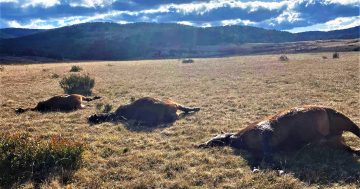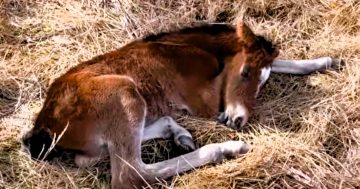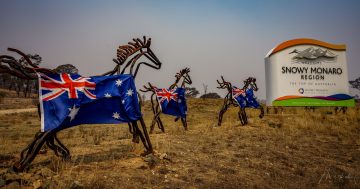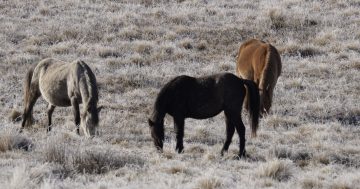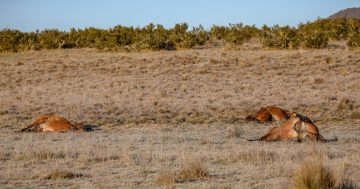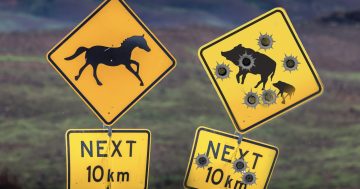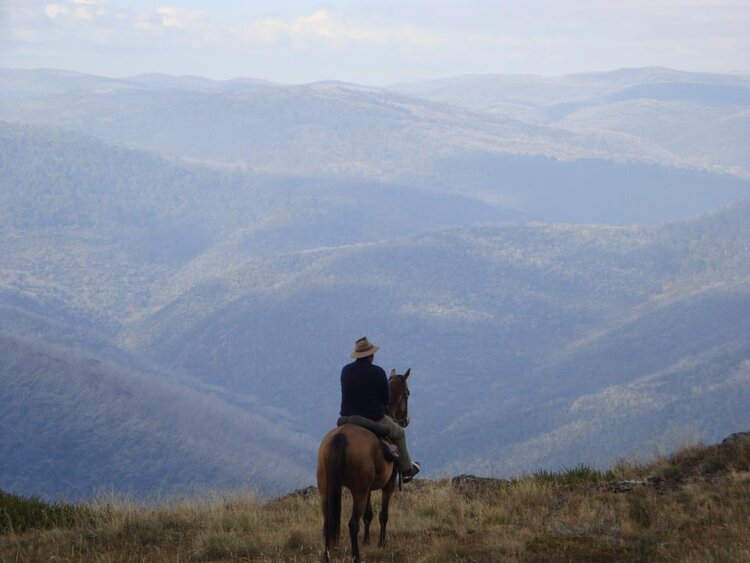
Peter Cochran looking over Kosciuszko National Park, where he says brumby numbers are diminishing in cruel fashion. Photo: Supplied.
As Peter Cochran slowly picks his way through the Snowy Mountains bush he will, from time to time, come across the carcass of a foal, mauled by dogs.
He says this is one tragic outcome of the NSW National Parks and Wildlife Service (NPWS) brumby trapping program in Kosciuszko National Park, which continues into high summer unabated, largely unpoliced and in defiance of stipulated welfare guidelines.
It’s just a horse whisker beyond foaling season with many of the young still unsteady and uncertain on their feet as they cling to their mothers for safety.
Peter has seen plenty of young ‘uns this year as he’s led teams of horses and riders through the charred wilderness. His business of running commercial horse treks through Kosciuszko National Park means he is up there five days a week, and he sees and hears a heck of a lot about what goes on.
He knows the mountains, the bush and the horses. He served in the army, Vietnam, was a state MP and, given his pedigree, all roads led to his passionate advocacy for the retention of wild horses in national parks.
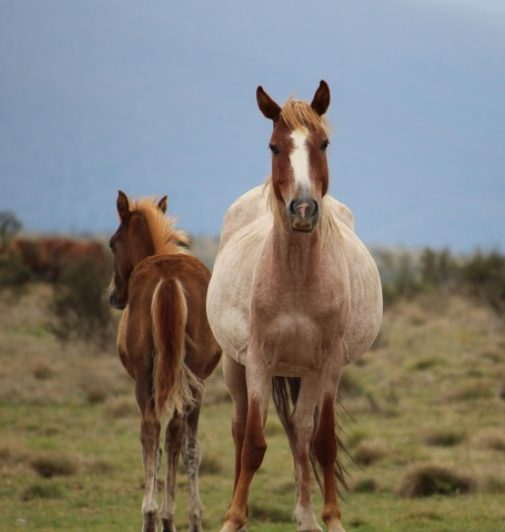
Trapping of brumbies in Kosciuszko National Park continues through the peak foaling season despite animal welfare guidelines. Photo: Supplied.
“It’s beautiful up there right now, absolutely glorious, the horses are fat, the people are fat,” says Peter, laughing. “It’s just a different place altogether compared to last year.”
But up in the mountains – where the worries of the modern world slip into the swamps – on vast plains and under steep mountains there might be plenty of foals, but far fewer horses.
“The population of brumbies is down to hell,” says Peter. “I’ve got people riding with me now, who haven’t been up here for a couple of years, noticing the number of brumbies missing and I’m not sure if that’s the case because of fire or what.”
“Or what” is the NSW Government’s campaign to reduce brumby numbers in the Australian alpine region in a bid to protect an ecosystem it says is under threat.
Tri-state surveys conducted under government dominion have shown wild horse numbers across the Australian Alps National Parks – in NSW, ACT and Victoria – increased from around 9000 in 2014 to 25,000 in 2019.
Peter is so sick of hearing that number he just sighs.
“It baffles me that they get away with it, but they do,” he says. “The numbers they claim were never there, yet this dispute over numbers keeps going on with a methodology being used by National Parks and Wildlife that’s just nonsense. The locals know just by being up there all the time. We miss individual horses you get to know.”
Last week, NSW Deputy Premier John Barilaro and NSW Minister for Energy and Environment Matt Kean confirmed the long-awaited post-bushfire recount of Kosciuszko National Park was complete, with data analysis underway.
Both offices said internationally recognised best-practice techniques were used to produce an estimate of the population, but these results won’t be released until they’re peer reviewed by independent experts.
But it was confirmed around 280 horses have been trapped and removed since trapping started in July 2020, with 94 per cent rehomed.
The NSW National Parks and Wildlife Service website confirms 14 horses have been sent to the knackery, with one trap-related death.
Wild horse control measures will continue to be implemented in three priority areas in Kosciuszko National Park: Cooleman, Kiandra and Nungar Plain.
This ongoing program beyond the accepted February to May and June to September periods has been condemned by many people with reports of foals separated from their mothers; horses, some being heavily pregnant mares, trapped in yards without water or shade during hot weather periods; allegations of urea, which is poisonous to horses, being used in salt lures; and ongoing questionable transportation practices.
“So far as trapping them at this time of year when there’s foals about and the foals are being run off their mothers – and we see them – we see the foals orphaned out in the bush so the dogs kill them,” says Peter.
The Invasive Species Council is offering a $1000 honorarium, to people willing to coordinate volunteers to get the 20,000 signatures required for a petition calling on the NSW Legislative Assembly to address feral horse impacts in the park before the 13 January expiration date.
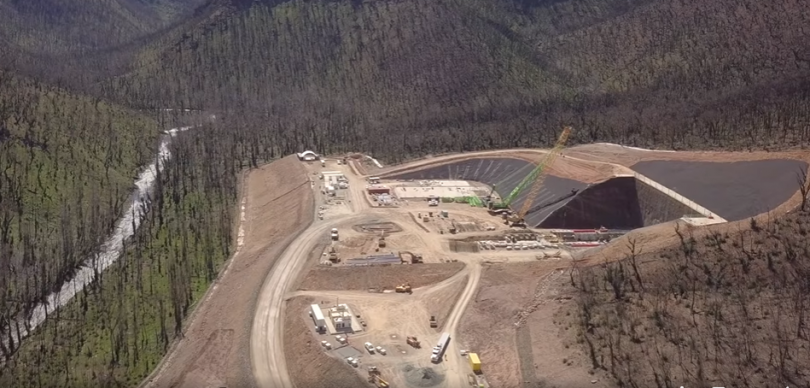
“We’ve got Snowy 2.0 ripping out the side of the country out there – massive destruction of the place – yet nobody is saying a damn word about it,” says Peter Cochran. Photo: Snowy Hydro.
The Federal Government has announced $8 million will be directed to Australia’s fragile alpine ecosystems to support the long-term recovery and mitigate the impact of hard-hooved animals following the devastating Black Summer bushfires.
Minister for the Environment Sussan Ley said recovery efforts would focus on rehabilitating the habitat of threatened species such as the northern and southern corroboree frog through feral animal control, weed control and threatened species management.
Peter says management of brumbies shouldn’t be about numbers, but rather should be about impact. Which leaves him a little goggle-eyed because areas untouched by fire were most heavily populated by brumbies.
“The greatest impact of horses is on Currango Plain around Tantangara Dam, and they’re not trapping there,” he said. “It’s extraordinary, but they’re doing it in remote areas where there are very few brumbies, which why they’re not catching any.
“Yet we’ve got Snowy 2.0 ripping out the side of the country out there – massive destruction of the place – and nobody’s saying a damn word about it.
“I happen to be supportive of the concept of the Snowy Hydro system, but for the duplicity in argument, the hypocrisy of the bloody thing is just beyond belief.”
Original Article published by Edwina Mason on About Regional.











